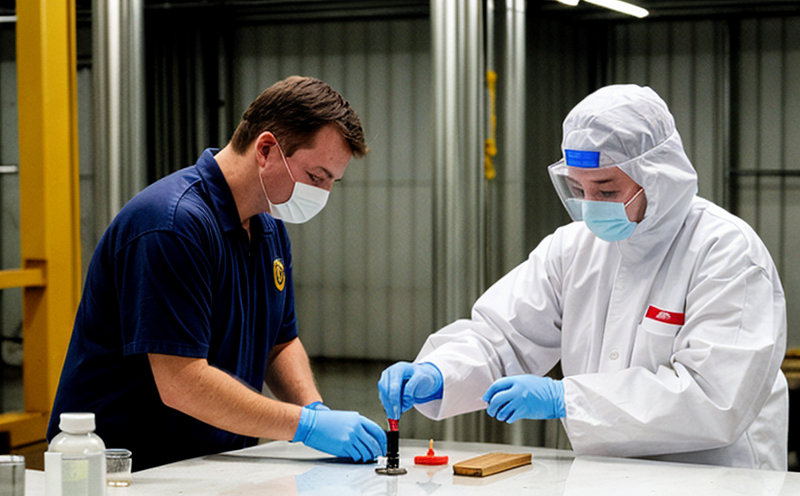ISO 22088-8 Thermal Aging Test
The ISO 22088-8 Thermal Aging Test is a critical procedure used to evaluate the thermal stability and durability of packaging materials. This test simulates the effects of prolonged exposure to elevated temperatures, which can help predict how well the material will perform under real-world conditions.
Thermal aging tests are essential for ensuring that packaging meets the stringent requirements set by international standards like ISO 22088-8 and ASTM F1383. By subjecting materials to controlled temperature cycles, this testing ensures that they remain functional throughout their lifecycle, especially in environments where heat stress is a significant concern.
The test involves exposing packaging samples to high temperatures for extended periods, mimicking the conditions they would encounter during shipping and storage. The goal is to determine if any changes occur within the material, such as cracking, discoloration, or loss of adhesion. These changes can indicate potential failures in the packaging's integrity, which could lead to compromised product quality.
The test procedure involves several key steps:
- Preparation of the samples: Samples are cut from the packaging material according to specified dimensions and tolerances.
- Initial conditioning: The samples are conditioned at room temperature for a defined period before testing.
- Thermal exposure: Samples are exposed to high temperatures (typically between 100°C and 150°C) in an oven or a controlled environment chamber. This step simulates the heat stress they might encounter during transport or storage.
- Reconditioning: After thermal aging, samples are reconditioned back to room temperature for specified intervals.
- Inspection and analysis: Post-thermal aging, the samples undergo visual inspection, mechanical testing, and chemical analysis to assess any changes in their properties. This includes checking for physical degradation, color change, or loss of adhesive strength.
The ISO 22088-8 Thermal Aging Test is particularly valuable for industries where product integrity is paramount, such as pharmaceuticals, cosmetics, and food products. By identifying potential weaknesses early in the development process, manufacturers can improve their packaging solutions to meet both regulatory requirements and consumer expectations.
Understanding the limitations of thermal aging tests is crucial. While these tests provide valuable insights into material performance under heat stress, they may not fully capture all real-world conditions. Factors such as humidity, light exposure, or mechanical stresses are not always accounted for in this type of testing. Therefore, it’s often advisable to complement thermal aging tests with other complementary tests that address a broader range of environmental factors.
Applied Standards
The ISO 22088-8 Thermal Aging Test is part of the ISO 22088 series, which provides guidelines for the thermal aging and stress cracking resistance testing of packaging materials. This standard ensures that tests are conducted in a consistent manner across different laboratories around the world, enhancing the reliability of results.
The specific requirements outlined in ISO 22088-8 include:
- Temperature ranges for thermal aging: Typically between 100°C and 150°C.
- Duration of thermal exposure: Varies depending on the material type, but generally ranges from 48 hours to several weeks.
- Post-aging reconditioning periods: Time allowed for samples to cool back to room temperature after thermal aging.
Compliance with these standards is crucial for ensuring that packaging materials meet the rigorous demands of global markets. By adhering to ISO 22088-8, manufacturers can demonstrate their commitment to quality and reliability, which is essential for maintaining a competitive edge in today’s highly regulated industries.
Industry Applications
- Pharmaceuticals: Ensuring that packaging materials remain intact during prolonged storage and transportation, which is critical for maintaining the efficacy of medications.
- Cosmetics: Protecting delicate formulations from heat-induced degradation, ensuring product quality and shelf life.
- Foods & Beverages: Maintaining the integrity of packaging to prevent spoilage or contamination during shipment and storage.
- Electronics: Ensuring that packaging materials withstand high-temperature environments without compromising the performance of sensitive components.
In addition to these industries, ISO 22088-8 is applicable across a wide range of sectors where heat resistance and durability are critical factors. The test helps manufacturers identify potential weaknesses in their packaging solutions early on, allowing for improvements that enhance product performance and safety.
International Acceptance and Recognition
- Global Standard: ISO 22088-8 is recognized worldwide as a benchmark for thermal aging testing. Its adoption ensures consistent and comparable results across different regions.
- Regulatory Compliance: Many regulatory bodies, including the FDA and EU authorities, mandate compliance with standards like ISO 22088-8 to ensure product safety and efficacy.
- Industry Best Practice: Leading companies across various industries incorporate this test into their quality control processes to maintain high standards of packaging integrity.
The widespread acceptance of ISO 22088-8 reflects its importance in ensuring that packaging materials perform reliably under heat stress. By adhering to these international standards, manufacturers can build trust with consumers and regulatory bodies alike.





